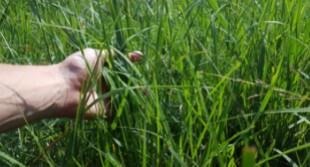By Ryan McGeeney
From record summer high temperatures to record winter lows and record 48-hour rain events in between, the unusual has increasingly become the norm in Arkansas’ weather.

LUSH & PLUSH — Lush regrowth of big bluestem after grazing. (Image courtesy Dirk Philipp.)
The good news for pasture managers is that grassland agriculture can cope with both wet and dry extremes better than perhaps any other form of agriculture.
Dirk Philipp, associate professor of animal science for the University of Arkansas System Division of Agriculture, said that the historically high variability in rainfall and temperatures throughout the Midwest accounts for the presence of such widespread grasslands in the area.
“It’s both the result of a continental climate with hot summers and cold winters and rainfall patters irregular enough so that trees were not able to establish permanently,” Philipp said.
A common feature of grasslands is their year-round closed canopy, along with a high species diversity of cool and warm season plants. The combination allows for a nearly continuous biomass production, Philipp said, vital for carbon sequestration and resilience to long-term environmental stresses.
“Cattle farmers can improve the resiliency of their livestock production systems by keeping a closed canopy year-round as well,” he said. “And by ‘closed canopy,’ we just don’t mean avoiding bare soil. Ideally, it also means growing grazeable forage year-round.”
Diversity is the key
Philipp said three key strategies will support growers striving for those conditions.
“Forage diversity is key,” Philipp said. “Extending the grazing season has been all the buzz, but that simply means closing ‘forage gaps’ and cultivating species that go beyond tall fescue and bermudagrass.”
Grasslands are dynamic ecosystems, he said, and pasture managers should ignore the impulse to fight every last weed in an effort to keep a “clean” pasture.
“The idea that you’re going to achieve 100 percent of this or that species is a mirage,” Philipp said. “If crabgrass becomes prevalent in bermudagrass, for example, just try to make the best use of it.”
After forage diversity, growers should be aware of “farm ecozones,” he said.
“Wet-laying areas should be treated as a valuable landscape feature,” Philipp said. “Grazing can and should take place there. But forcing a landscape toward certain forage species may not work.”
Legumes, for example, need a lot of water, so growers should plant them in low-laying area where long-term persistence is more likely, he said.
Finally, Philipp advised pasture managers to be diligent with grazing management tools.
“Don’t be afraid to reach deep into the toolbox of grazing methods and management strategies,” he said.
Modern fence technologies and equipment, for example, allow for rapid adjustments of grazing pressure, which can help control plants such as johnsongrass and reduce woody vegetation if necessary.
“Yes, farmers need to maximize the return per acre, but that depends highly on growing grazeable forage first and foremost,” Philipp said. “Experiment yourself and find out what forage species and grazing management works best on your place.”
Source : uada.edu